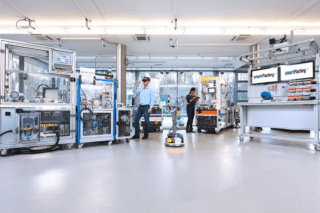Machines that tell operators when they are going to break down, and how, are no longer a fantasy. Research from IoT Analytics, a market insights firm, says predictive maintenance is already one of the leading use cases for the industrial internet of things (IIoT). It found the market for these applications is set to grow from $2.2 billion in 2017 to $10.9 billion by 2022, an annual growth rate of 39%.
But predictive maintenance is no longer the Next Big Thing. In 2016, Dan Miklovic, research fellow with LNS Research, put forward the idea of prescriptive maintenance: analytical systems that not only predict when maintenance becomes necessary, but also prescribe actions to avoid the worst outcomes – both in terms of a technical fix and also operational changes to minimize the impact of maintenance and downtime. On his blog, he says:
“The idea is that the analytical tool not only can predict what is likely to occur, but it can offer ‘what-if’ analysis of alternatives to provide a scenario that can alter the outcome,”Vendors have been paying attention. IBM has already set up its Prescriptive Maintenance on Cloud platform and is set to launch a range of new related technologies using its IBM Watson set of AI services to build up its prescriptive maintenance portfolio.”
Stephan Biller, vice president of IBM Watson Internet of Things, says:
“Whereas predictive maintenance helps forecast where problems might occur, prescriptive maintenance might look at an entire factory of a thousand machines, with a limited workforce, and decide who can do maintenance, which machines to work on first, which batches, or items, are most important in the production run.”
As well as informing operational decisions, Biller says prescriptive maintenance helps engineers. This is where IBM’s Watson services for absorbing domain knowledge and answering natural language questions will come into their own. To help with the diagnosis of a problem, Watson can “read” thousands of pages of machine instructions, documentation and maintenance history, including notes from engineers who have worked on the machine before. It can build up a picture of current based on IoT sensor data and historical performance and it will learn over time, as Biller points out:.
“It can answer questions in natural language. This is really important to manufacturing. It can make your average technician perform as your best technician and make all your technicians more productive. Also, a lot of manufacturers worry that when their best maintenance engineer retires, their knowledge will go with them. The system helps to retain that knowledge.”
But prescriptive maintenance goes much further than simply fixing or preventing machinery failure. Biller says it can influence company-wide operational decisions.
For example, commercial aircraft maintenance is incredibly complex. If an airline becomes aware of a non-urgent aircraft maintenance issue well in advance, it might look into how to change its flight plans in order to minimize downtime. With a wealth of analysis of historical performance data available, it could decide which routes – short or long haul – might avoid exacerbating the issue and make the maintenance job easier, Biller notes.
“In a factory you might decide to make product A and not product B for a short period in the run-up to the maintenance period. You could also reassign people, taking them from operations to maintenance. All this can be optimized to get the most from a factory.”
To benefit from the concept of prescriptive maintenance, industrial companies need to be aware of some difficult questions. Equipment manufacturers may themselves embed IoT sensors into their product and recommend their data solution or platform to analyze it. Their customers should be wary of such an approach, Biller says.
“We mostly work with the users of those machines. Although we’re not at all opposed to working with the machine manufacturers, the vast majority of users have equipment from many manufacturers and only want one maintenance system.”
While industrial firms are beginning to understand the concept of prescriptive maintenance, they need to have the right culture, approach to data and data infrastructure to benefit from it, Biller says. Most companies start with conditions-based maintenance, and move up the ladder over time, he notes.











